According to analysts, there are over 2.5 billion gamers on Earth, with 323 million of them living in Europe. This market generates close to £28 billion, creating a rich market that is bound to attract innovation and R&D spending. We recently met up with the teams at Philips/Evnia/AOC/AGON to see what's on the horizon in the gaming monitor market.
According to data specialists NewZoo, there are now more than 2.5 billion gamers on planet Earth. Over 323 million of them live in Europe and, of those, 125 million prefer gaming on their PC.
Right now, TPV (the company behind Philips, AOC, Agon and Evnia) produces almost one-third of the world’s displays – including the underlying technology for many products that would normally be seen as ‘rival brands’. That’s an interesting position to be in if the global production for panels hits a projected 182 million units by the end of 2023. When it comes to monitors sold in Europe, the combined Philips/AOC brands are now in the number two spot, but – according to Xeni Bairaktari, Global Marketing Lead of Philips Monitors and IT Accessories – they are aiming even higher.
Graphics card prices are finally coming down and the latest GPUs deliver a phenomenal amount of frames per buck – as detailed in Dominic’s recent analysis of this subject. While there is still a big emphasis on image quality, technologies like DLSS from Nvidia and FidelityFX from AMD, mean that average throughput is reaching new heights.
To keep pace, modern gaming monitor designers are having to look past yesterday’s refresh rates – focusing on 240Hz and beyond. The following chart is based on sell-in data from retail research specialist Context. It shows how the market is evolving when it comes to high-end monitor technologies. As you can see, QHD and UHD now account for 34% of screens sold in this market – with 21:9 and 32:9 ultra-wide screen ratios set to become more popular.
| 2020 | 2021 | 2022 | 2023 | |
| 144/165Hz | 67% | 60% | 52% | 47% |
| QHD | 23% | 26% | 27% | 30% |
| 240Hz+ | 6% | 10% | 13% | 17% |
| UltraWide | 6% | 6% | 10% | 10% |
| UHD | 0% | 1% | 3% | 4% |
| OLED/MiniLED | N/A | N/A | N/A | 2% |
From a time when 1ms GtG responses were considered premium, we’re now looking at OLED panels capable of moving from grey to grey in 0.03ms. At some point, the market may need to consider moving from milliseconds to microseconds when describing screen speeds. Lastly, in terms of new technologies, MiniLED brings in a high peak brightness and the possibility of more than 1,150 local dimming zones.
All of these technologies and more can be found in the latest products released under the dedicated gaming brands Evnia and Agon.
Down in the Evnia 3000 series, they are launching the 25M2N3200W monitor that offers a VA panel with FHD resolution, 100% sRGB and a refresh rate of 240Hz. It will retail close to £199.
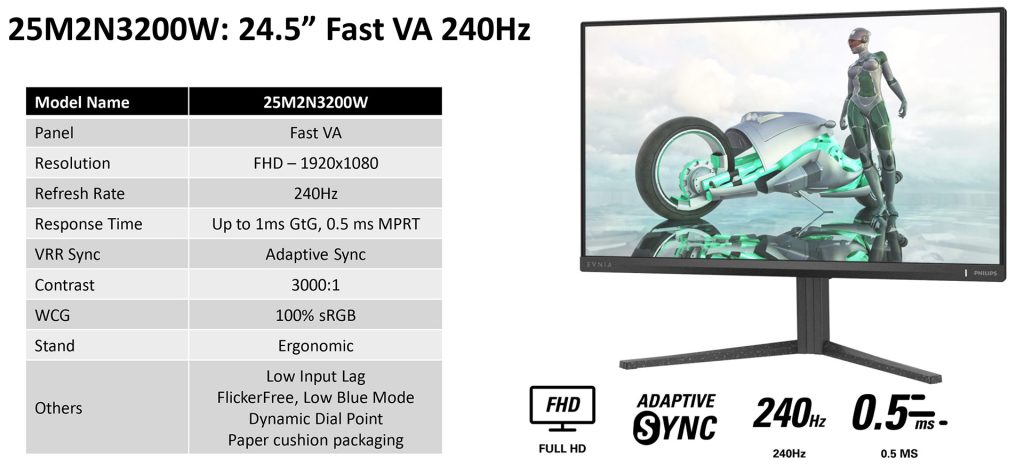
Much faster will be the Evnia 25M2N5200P. As we reported back in April, this 5000 series screen comes with adaptive sync, but with an IPS panel refreshing at 280Hz – we’re not sure you’ll need it. The display promises good image quality as it covers 110% of the sRGB colour space. It also meets the HDR10 spec and includes a four-port USB hub as well as offering a 1ms GtG response time, for a price close to £270.
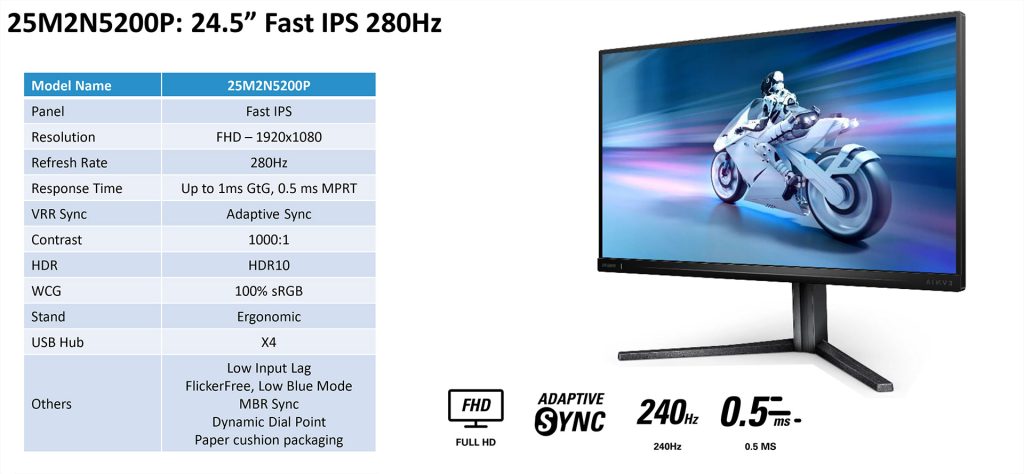
One of the fastest growth areas for Philips/Evnia/AOC/Agon is in ‘very fast refresh’ rate panels. The demand for screens that can refresh at 240Hz or more has almost tripled since 2020. The new Agon Pro AG6 series looks to capitalise on that demand, by offering the latest OLED panels in a frameless design, minimal desktop footprint, integrated cable management, HDR, 0.03ms GtG and a 98.5% DCI gamut. The AG6 series also has an integrated Agon Light FX RGB system, capable of more than 10,000 combinations. The monitor we were shown is the AG276QZD and it will be a QHD unit. It's expected to be in store for less than £1,000 before the end of June 2023.
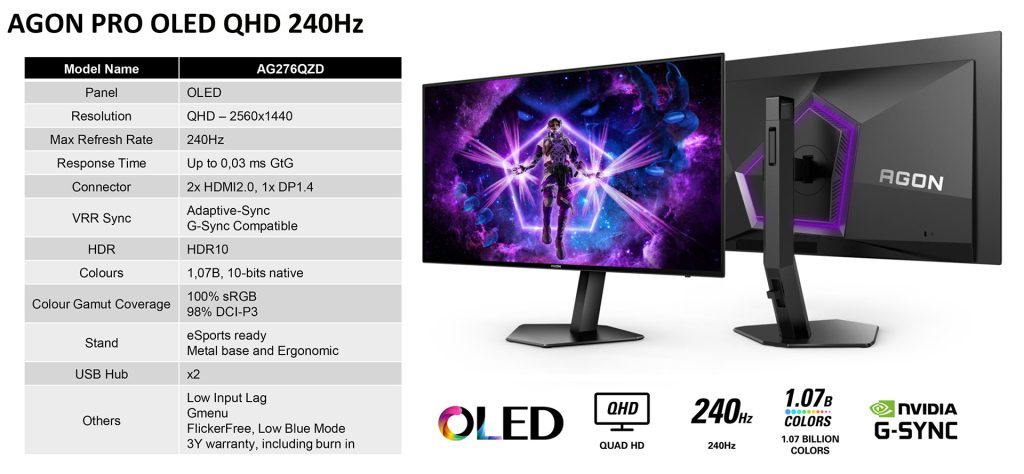
If you fancy something more substantial on your desk, then the Agon AG405UXC might be worth a look. This screen has a 40” wide IPS panel that refreshes at 144Hz with a 1ms response time. As well as HDR400 and an integrated USB hub, it also has a 90w USB-C port with KVM support. Also arriving in June, the AG405UXC will be in stores for less than £699. It would be interesting to see this size of screen offered with a curved design, but that can drive up the price, so we'll have to wait and see which way the company decides to go.
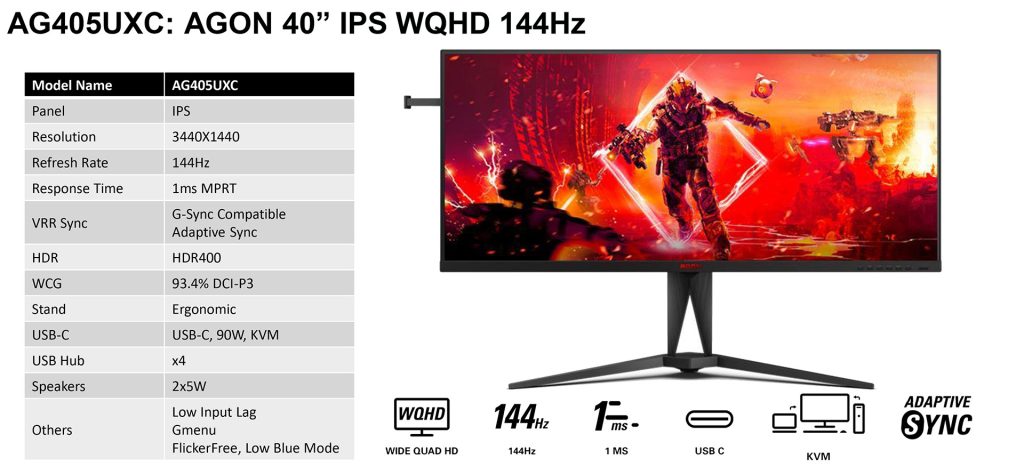
Another point emphasised during the presentation was the idea that we should all be demanding higher pixel density. We were told that while 80 pixels per inch is considered far too low for most users, many people will be happily gaming with a screen that has a PPI between 90 and 110. For those who want a 24” QHD monitor that has a much higher pixel density, there is a new AOC Q24 G2A, featuring a new IPS panel with a density of 123 PPI. Depending on exchange rates, this could be in the market for as little as £220.
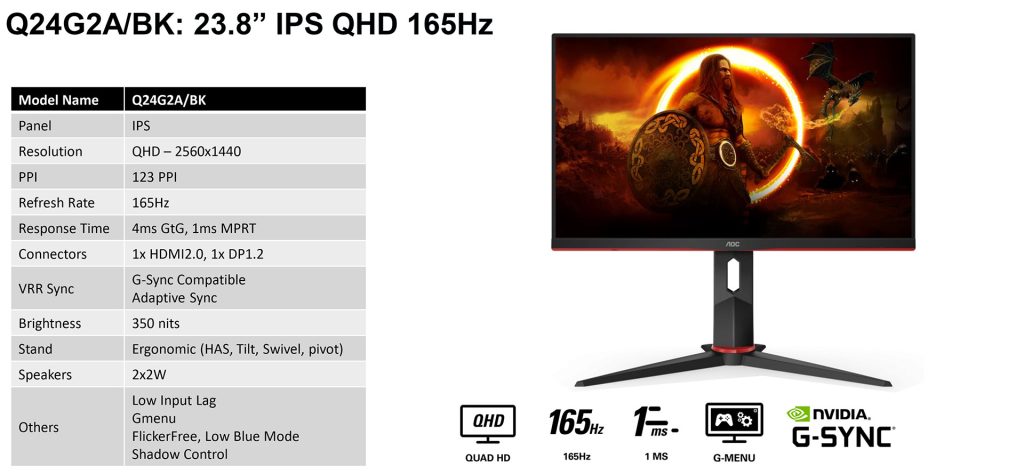
Completing the new launches is the GH501 wireless headset. This is due to land in July with a 70-hour battery, tuned 50mm drivers, DTSX audio, a choice of ear muff types (soft touch and leather-like are both included in the box) and a price tag of close to £87.
We expect the number of launches under the Evnia and Agon brands to increase throughout this year and beyond.
KitGuru Says: Are you currently shopping around for a new gaming monitor? What is your ideal spec and price point?
 KitGuru KitGuru.net – Tech News | Hardware News | Hardware Reviews | IOS | Mobile | Gaming | Graphics Cards
KitGuru KitGuru.net – Tech News | Hardware News | Hardware Reviews | IOS | Mobile | Gaming | Graphics Cards


